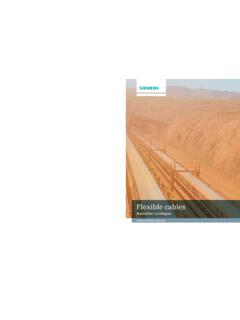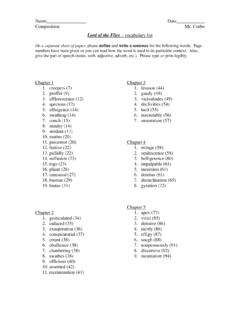Transcription of Summary of Undersea Fiber Optic Network Technology and …
1 Summary of Undersea Fiber Optic Network Technology and SystemsBy Adam Markow Senior Telecom AnalystThe source of many of the slides is from The David Ross Group view of the Global Submarine Cable Network (TeleGeography) Undersea System ElementsRepeatered ExamplesRepeatersBranching UnitSubmarineCableTerminalStationsTranso ceanic NetworkCoastal NetworkUsing the same elementsUndersea System Elements -Non-Repeatered Examples Inter-island NetworkSubmarineCableTerminalStationsCoa stal NetworksUsing the same elementsTrunk & BranchFestoonRepeaterless vs. Repeatered: Limited to <400 km span lengths Sometimes, but not always Less expensive initially More flexible long term Less expensive to operate & maintain More complex to upgrade Historical advantages of repeaterless offset today by current market oversupplyof repeatered production capability and inventoryThe choice between repeatered & repeaterlessmust be made on a case by case basisSource The David Ross SectionConnecting a Terrestrial Network with and Undersea SystemN x STM-1oTelehouseSLTE Submarine Line Termination Power Feed Equipment (pushes constant current of ~ A across Undersea cable link from CS to CS)Ocean groundBackhaulConnectionN x STM-64)ADMADMC able Station & Beach ManholeADMC able Station Floor PlanGCL Cable Station Requirements.
2 At least 17,000 square feet (~1900m2) of total areaRaised floor, with minimum load tolerance of 500 kg/m2 Useable height of at least cable vaultsDC -48v power, with battery backup for at least 1 Engine emergency backupHVAC to maintain room temperature between 22 - 24 CRing GroundFire/smoke detection, with connection to emergency/control center24 hour access for maintenance and repairTransmission EquipmentCollocation for backhaulMeeting/training roomBatteryCable Station Transmission ComponentsLINE PAIR #1 LINE PAIR #4 OpticalConnectionsof Terrestrial Linkconnecting to Data CenterLineMonitoringEquipmentUndersea CableLineCurrentPowerFeedEquipment Orderwire & MaintenanceSDHT erminalCableStationSLTEO rderwire & MaintenanceSDHT erminalSLTELand Plant Line Terminating Equipment OpticalLineToUndersea CableLine AmplifierDWDMW avelength TerminatingEquipmentHighPerformanceOptic alEquipmentToSDHE quipment 1- NN21 Land Plant Line Terminating EquipmentSource NECORX ShelfSTM-16 Timing GeneratorOHTRMFECDECODEROHT iming GeneratorOHTRMFECDECODEROHT iming GeneratorOHTRMFECDECODEROH10G GeneratorOHTRMFECDECODEROHFEC DECDMUXFRMSYNC&DSCRDSCR ShelfOHINSTIMING GENERATORFECENCODEROHOHINSTIMING GENERATORFECENCODEROHOHINSTIMING GENERATORFECENCODEROHOHINSFECENCODEROHFE C COD10G
3 ORXSTM-16 STM-16 STM-16 Source The David Ross Plant SDH Ring TerminalOptical Line ToUndersea CableLine AmplifierWavelengthTerminatingEquipmentH igh PerformanceOptical EquipmentNetworkProtectionEquipmentSDH MultiplexEquipmentDuplicated Per Fiber PairSource The David Ross Plant Network Management EquipmentPower Feed EquipmentLine MonitoringEquipmentUndersea Line EquipmentTLAWTEHPOESDHI nland Network (optional)Vendor Equipment Element ManagersNetwork ManagementSystem EquipmentNetwork ManagementSystem WorkstationSource The David Ross Plant Power Feed EquipmentHV PFE ConfigurationPR1800 mmCONV(4)CONV(3)CONV(2)COMCONV(5)CONV(1) PR2800 mmCONV(9)CONV(8)CONV(7)COMCONV(6)PM800 mmCURR CONT& C/V SENSORLT800 mmLOAD TRFCOMNSW800 mmSW&RETURN& EARTH TESTTL2TL1800 mmFANTEST LOAD800 mmTEST LOADFANRECORDEROPE & MONI1,800 mm*The depth of the frame: 600mmBLANKS ource KDD SCSC able Station and Beach Manhole2025 Taft Street - Hollywood, FloridaThe optronic connection that starts at Optical Distribution Frame (ODF) in the Cable Stationand then continues to the ODF at the City Service Point, the Telehouse.
4 Then a separate connection of the circuit is made to the frame of the carrier who will then take traffic back to the end customer premise. Global Crossing Backhaul in Hollywood, FloridaCable StationUndersea Cable Landing Configuration Submerged Plant Beach Manhole Shore Section Land Sections Terminal Station Terminal Station EquipmentLand SectionLand SectionBeach ManholeBeach ManholeTerminal StationTerminal StationPower FeedPower FeedEquipmentEquipmentOptical & Optical & TransmissionTransmissionEquipmentEquipme ntRepeaterRepeaterCableCableNetwork Network ManagementManagementBranching UnitBranching UnitYes, the cable really does rest on the Ocean Floor!Cable ShipRepeaterSubmarine MountainSubmarine Cable South America Physical Map South America ERZ border at 12 nmi South American Crossing Segmentsare mostly outsideof the ERZERZ = Economic Resource ZoneInstalling a Submarine Cable SystemSource The David Ross Long LinesLONG LINESYEAR OF BUILD: 1963 LENGTH: BREADTH: DRAUGHT: DEPTH: FLAG: UNITED STATES OF AMERICASHIPBUILDER: DEUTSCHE WERFT HAMBURGCOUNTRY OF BUILD: FEDERAL REPUBLIC OF GERMANYSTATUS.
5 IN SERVICE/COMMISSIONC able Ship Profile Tyco TelecomG129428 Cable Laying and BurialPhases of Cable System Network Planning, Finance & Procurement Carrier Partnership Business Plan Preliminary Network Design & Desktop study Finance Procurement Survey Route engineering Network engineeringDeployment License & Permits Terminal Station Construction Manufacturing- Undersea and Land Plant Undersea Plant Assembly & Load Undersea Installation Shore end and cable burial Deep water i Branching unit Final Splice Terminal Station Installation Commissioning & Acceptance ServiceService, Operations & Maintenance System Provisioning Station & NOC Operations Cable Maintenance agreement (Cable recover, splicing, repair, relay, rebury) Network UpgradesSurvey VesselInstallation ShipSea Plow for CableBurial OperationMaintenance VesselSt. Croix Shore End - SAC,2000 After years and the cable should break, the cable must be Plant Land Cables Terminal StationsLand Plant Land CablesHigh DensityPolyethyleneJacketCopper/Stainles s SteelBimetal ArmorCore TubeFilling CompoundLightpack Fiber Bundle4-48 FibersTMColor Coded BinderHelical Lay WireStrength MembersFiber CableSource - TycomLand Plant Land CablesPolyethylene JacketPolyethylene JacketCopper TapeCopper TapeSemiconductor LayerSemiconductor LayerInsulationInsulationStrand ScreenStrand Screen#6 Copper Conductor#6 Copper ConductorPower CableSource - TycomLand Plant Terminal Station Equipment Line Terminating Equipment High Performance Optical Equipment Wavelength Terminating Equipment Line Amplifiers SDH Network Protection Equipment SDH Multiplex Equipment Line Monitoring Equipment Network Management Equipment Power Feed Equipment Synchronization Equipment Test EquipmentTerminal Stations Typically terminate Undersea signals.
6 And interface with domestic Network Most often very close to beach Construction & features very similar to other telecom offices, such as Central Offices, but include some unique aspects In multi-point coastal systems, costs can become significant element of Network cost. Large stations cost $10-$15M. Very small stations <$5M. Permissions and Rights Of Ways associated with construction and beach access, plus actual civil construction, together often dominate overall Network construction schedule In small, regional networks, alternate more efficient options (prefabricated huts) may be possibleSource The David Ross Plant Cable and Fiber Repeaters Equalizers Branching Units Marine InstallationUndersea Plant Cable and Fiber Specified for each span of each system Typically 1 to 4 types of cable depending on type of environmental protection needed Typically 1 to 3 types of Fiber depending on required management of optical transmission properties Network costs vary widely depending on types of cable (increase dramatically in vulnerable areas)
7 Submarine Fiber CablesComparison of Coaxial and Fiber Optics CableUndersea Optical CableTyco Standard design < 2000 OPTICALFIBERUNITFIBERSTRUCTURESTRENGTHWIRESCOPPERSHEATHINSULATIONJACKETARMORED PROTECTIONLAYERU ndersea Plant Cable Types Rock ArmorSPA(Special Purpose Armor)LWA(Light Wire Armor)SA(Single Armor)DA-HS (Double Armor,High Strength)DA-HA(Double Armor,High Impact)LW(Lightweight)Source TycomVarious Cables and ApplicationsVarious Cables and Applications Undersea Cable Types: Power & Ground Cable Land CableUndersea CableDouble Armored (DA)Single Armored (SA)Light-Wire Armored (LWA)Special Application* (SPA)Light Weight (LW)Typical ApplicationBeach Joint to 400 Meter Depth400 to 900 Meter DepthBuried900-2,000 Meter Depth>2,000 Meter Depth*Fish Bite Protected CableUndersea Plant LW Cable Lightweight cable Used in deep water where hazards are minimal Comes in three outer diameters 10-12 mm, used in non-repeatered systems 17-19 mm, used in several recent repeatered systems 21-23 mm, used in repeatered systems wherever the additional size is deemed necessary or desirable Cost varies in proportion to Plant Armored Cable Armored cable Used in shallower water where hazards from abrasion, fishing activity or anchors warrant Comes in several varieties SPA, for light abrasion or fishbite protection LWA, for harsher abrasion SA, for light marine activity DA, for heavier marine activity Rock armor, for the most challenging environments Specified jointly by supplier, installer, and purchaser Armor is costly, takes more time to produce, load, lay Result.
8 Systems in difficult environments cost much moreUndersea Plant- Repeaters Repeater Performance designed to match needs of system Two sizes presently available 1 to 4 Fiber pair 5 to 8 Fiber pair One optical amplifier per Fiber Costs strongly dependent on number of Fiber pair Cost also dependent on performance Spacing (between repeaters) set for system performance / cost, and typically 50-80km Shorter spacing generally yields higher ultimate capacity In long (many thousand km) systems, often largest single component Network costUndersea Plant RepeaterAppr ox . 1300 Appr ox . 1500 Appr ox . 1400 App r ox . 1500 Appr ox . 4400 Cab l e Te rmi na t i onCa b l e Te rmi n a t i onRepe a t e r Hou s i ngTa i l Ca b l eCa b l e(between PIN to PIN)(Repea t e r Hous i ng )Be l l owsApprox. 265 Approx. 250 Approx. 230 Source - NECU ndersea Plant RepeaterAmplifier Pair ChassisPump UnitControl CircuitErbium AmplifiersSupervisoryHeat Transfer PlateLocking PlatePower Supply4 Amplifier Pair RepeaterSource TycomTSSL Repeater < 2000 Laser PumpDriverOptical AmplifierPairRepeaterHousingCable to RepeaterCouplingRepeater EndCover69cm(27 )33cm(13 ) Undersea Plant Equalizer Performance designed to match needs of system Inserted at periodic intervals as needed One equalizer per Fiber Cost strongly dependent on number of Fiber pair Higher capacity systems generally require more exotic equalizationUndersea Plant EqualizerSource - NECP ressure HousingEqual i z e r M o dul eCable CouplingUndersea Plant Branching Unit All currently produced are three-terminal One or more Fiber pair may be branched Fiber connections or powering may be switchablefrom a shore terminal or NOC for restoration or security Wavelength branching (Optical Undersea Add-Drop Mutiplexing)
9 Has been done on a limited basis Cost is strongly dependent on degree of complexity and number of Fiber pairUndersea Plant Branching UnitSource - NEC Approx. 4600 Cable TerminationApprox. 1245 Housing Unit(Pressure Housing)Gimbal Joint1700 CableTail CableApprox. 1260 Cable TerminationBellowsApprox. 4801700 Undersea Plant Marine Installation Uses specially designed cable-laying vessels and tools Costs strongly dependent on Water depth Types of cable and protection employed Bottom characteristics Burial depth required Number of shore landings and branching units Number of cable and pipeline crossings Distance of lay from cable factory WeatherDeployment Timeline Economies to Be AchievedTraditional Procurement CycleNetwork PlanningDesktopStudySurvey ProcurementSupplyProcurement &ContractSurveySystem ManufactureSystemInstallationOperationsR eadinessTestingTypical 2 Year TimelineFinancingSource The David Ross Network Construction Elements Wet Plant Dry Plant Terminal Stations & Backhaul Marine Work Network Operations CenterNetwork Construction Cost& Payment Schedule Typical Network Costs (1998-2001): $30-40K/km, plus stations Today s Discounted Network Costs, with Market Oversupply.
10 $20K/km, plus stations Work Typically Begins with secure finance, followed by secure supply contract 5-10% down payment Periodic milestone-based progress payments during construction period, cumulating to 75-85% before service begins Additional 10-15% at start of service Last 5-10% at final acceptance months thereafter Work might begin earlier via an ITP IFpurchaser guarantees payment for all supplier expenses prior to secure contract Today s oversupply market offers huge discounts for purchasers,but minimal opportunities for vendor financeCosts After the Initial Installation Operation and Administration Maintenance and Repair Network UpgradesCosts After the Initial Installation Operation and Administration In consortium and domestic systems, operation handled by experts landing-party carriers. In private systems, operation provided by carriers carriers or outsourced to suppliers. Involves staff at cable stations and the Network Operations Center (if any).




